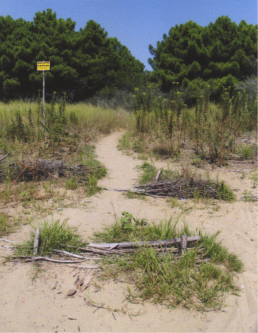Aliens in the dunes
Alien species are animal and plant species introduced by humans into areas outside their original range. In many cases, the new species are unable to adapt to the new environment and disappear after a short period. In other cases, they not only adapt but also spread very quickly to become invasive alien species.
The alien flora of coastal habitats
Despite their naturalistic value and ecological functionality, dune ecosystems share a long history of exploitation and mismanagement. The resulting environmental problems include habitat loss, impoverishment of the natural landscape pattern, a reduction in the resilience of plant communities and the spread of alien species, which have become increasing threats to native species.
Below we describe two of the most invasive alien species present among the flora of the coastal dunes of the Northern Adriatic.
Oenothera stuchii.
Oenothera stuchii is a hybrid originating in northern Italy from naturalised populations of Oenothera biennis L. and O. jamesii. The first report of O. stucchii along the Veneto coast dates back to 1952 and, after a period of pause, it now seems to be in the expansion phase.
The high success in spreading demonstrated by the species of the genus Oenothera is related to their ecology. Their two-year life cycle ensures their resilience and tolerance to disturbance: in the first season the seedlings sprout and the growth of the vegetative organs begins, while the generative phase is reached only the following year with the production of the epigeal portion. This two-phase germination can be blocked for years while waiting for favourable vegetative conditions. Seeds have a strong affinity for light and can go through a very long dormancy period in the sand, creating a "seed bank", while human activities (trampling, collection of materials, removal of sand...) bring them back to the surface, facilitating germination. The strong tendency to grow in the light, the rapid growth and the high number of seeds (5,000 - 12,000 seeds per plant) determine Oenothera stucchii's strong tendency towards invasiveness.
This plant also prefers habitats with wide open spaces, lots of light and a sandy substratum, conditions that make it more competitive in environments disturbed by human action, unlike endemic species that do not survive trampling.
The Life Redune project contains the propagation of Oenothera stucchii with an activity of emanual eradication within 150,000 square metres. Weeding takes place at the beginning of the growing season, around May, to prevent the production of new seeds and fruit..
Rosa rugosa
Rosa rugosa (or Rosa canina) is native to the Far East, where it is considered a wild plant. It has also spread to Europe and North America where it is especially cultivated for ornamental and decorative purposes. It is a perennial, very robust plant that tolerates frost and heat, drought and sandy soil.
Rosa rugosa is an upright, bushy species that can grow to one metre in height. The reason why it is called 'wrinkled' is because of its leaves, which have characteristic veins that turn very attractive colours in autumn. It blooms throughout the summer season, the flowers are quite large and can appear alone or in groups and have a very delicate scent.
The individuals that colonise beaches come from plants grown in gardens, but Rosa rugosa, due to its rusticity, is also often used in flowerbeds and along roads.
Rosa rugosa has a strong negative impact on native species richness due to its shading effect which reduces light on the ground. It also has a negative social and recreational impact on beaches as the invaded dunes become impenetrable due to the numerous thorns on the stems and branches.
The Life Redune project constantly monitors Rosa rugosa populations in the project's habitats to assess their rate of expansion and colonisation. In order to contain the spread of Rosa rugosa, Life Redune, together with voluntary environmental associations, organises bioblitzes to eradicate Rosa rugosa plants.
Invasive alien species represent one of the main environmental emergencies and are considered by the international scientific community as the second most important cause of biodiversity loss on a global scale. Their expansion threatens biodiversity, but often also has major socio-economic impacts, with direct damage to health or human activities.
Often the introduction of alien species is unintentional. However, many of the most widespread and dangerous invasive alien species have been imported into our country voluntarily. It is therefore important that everyone develops an awareness of the problem, thus transforming themselves from a potential vector of introduction to a sentinel against the further spread of invasive alien species.
For further information, see the website of the Istituto Superiore per la Protezione e la Ricerca Ambientale : https://www.specieinvasive.it/index.php/it/
In addition to the framework of the problems related to the introduction and spread of invasive alien species, the site contains the reference legislation, documents and technical guidelines useful for the correct application of the rule and the files of all the species included in the list of EU relevance for which a series of obligations and prohibitions are in force.



